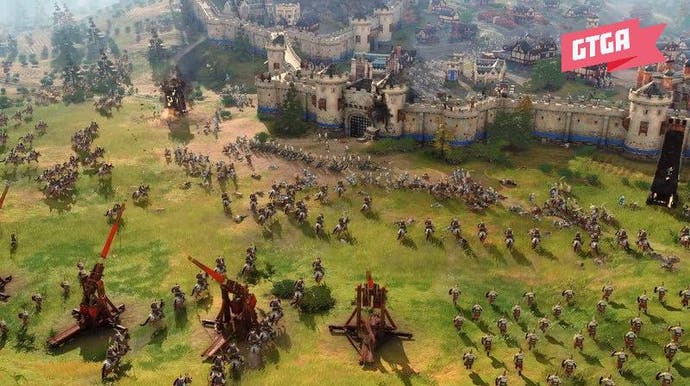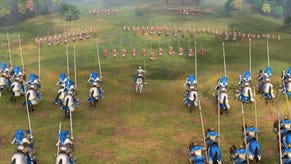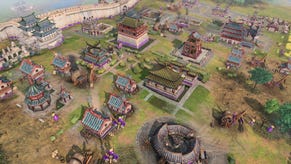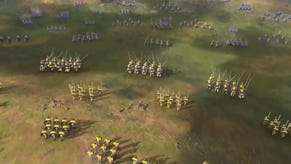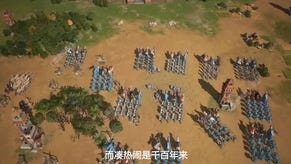Age of Empires 4 review - the classic RTS rediscovered and restored
Wololonderful.
Editor's note: Hello! Over the next few days we're running a "Games That Got Away" series, where we finally get round to reviewing games that released at some point in 2021 but, for various reasons, we couldn't quite manage to cover at the time.
We've gone back to a few real gems, so for more catch-up reviews like this one head to the Games That Got Away hub, where all our pieces from the series will be rounded up in one convenient place. Enjoy!
Great first game; classic sequel; much-maligned third entry that takes an admirable but clearly doomed stab at something different; hiatus; and finally, a triumphant, boots-on-the-ground return to the classic formula. We've been here before! Forgive me for a truly agonising cliché with this one, but it does feel like history is repeating itself with Age of Empires 4.
Thankfully, that history is really quite good. Age of Empires is the game of the before times, after all, the pinnacle of pre-Y2K. The first came out in 1997, the second in 1999. The time of beige PCs, dial-up connections and the early internet's fabled golden age. This is the era right now. The pendulum has swung to crop tops, cargo pants, curtain haircuts and, apparently, historical real-time strategy games about little men in castles. Savour this one, because as quick as life giveth it can taketh away: the classic RTS is hot.
And AoE 4 feels about as classic as classic RTS games get. It's stripped back, simple (on the surface) but in a way that feels streamlined, light on its feet, as opposed to lightweight. There's a clarity to it's ever-so-slightly stylised visuals, and a famously basic core, the formula that worked so well with the earlier games of the series - and little more. Four campaigns, some premade and custom skirmishes, perfectly functional online multiplayer (that's admittedly still waiting for its ranked mode), and a handful of tutorials. It needs nothing else.
In a weird way, the tutorials might be one of my favourite things about AoE 4. Building a good explainer for new or long-lapsed players that actually brings you up to some kind of functional standard is an underrated craft, especially in this genre, but here Relic has quietly nailed it. Instead of leaving it at the early-game foundations, AoE 4 teaches you how to set yourself up for a mid-game economic boom, to rapidly siege a town and surgically remove its landmarks for a quick win. Of course there's much, much more to master beyond that, but there's a real challenge to hitting the "gold" rank with each tutorial, and doing so will genuinely help as you venture into the hugely competitive games against fellow humans online.

What it strikes you with, really, is a sense of reverence. This is as storied a series as it gets, and the people who love it are the kind who picked up the first one a good 22 years ago and never really put it down. It's a good job really. With AoE 4, Relic - alongside the new, Xbox-owned studio World's Edge - has taken over from original developer Ensemble and in the process anointed itself rightful defender of the RTS crown. Age of Empires joins Company of Heroes and Dawn of War in Relic's catalogue of highly regarded strategy series with decades of history behind them. There must've been some pressure felt over there in Vancouver.
The easy thing would be to point out how safe AoE 4 is as a result, especially in light of that very predictable cycle of back-to-basics sequel after the less impressive third entry, and it really is safe - but that's also a little harsh. Playing it safe with a series like this comes with its own risks: you can't take aim at a game like Age of Empires 2 and do anything but nail it. For the most part Relic really has.
The campaigns, with about eight to ten missions each, spread across the Norman, French, Mongol, and Rus factions, are largely great fun. The Norman and French are mostly variations on "capture this castle" and "defend this castle", with a sprinkling of "save this village" and "raid that village" in between, but seemingly so was much of military life in the eleventh and twelfth centuries, so fair enough. The big twist is the addition of narrated, real-world footage delivered between campaign missions, which have that enjoyably anorakish, Time Team whiff to them that you find on a mid-budget, mid-noughties terrestrial history show here in the UK. As much as Age of Empires in general takes me back, AoE 4 takes me back to somewhere around Year 5 of school specifically, with some budget-friendly trips to crumbly old keeps around the country. Here's a nice drone shot of Lincoln town centre. Here's a field in Hastings. And oop - hold onto your hats - we're off to France!
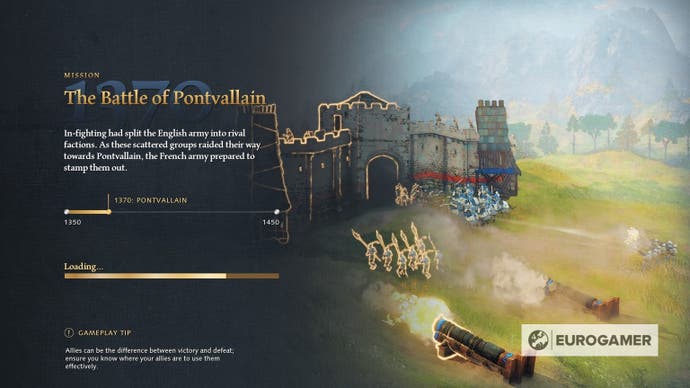
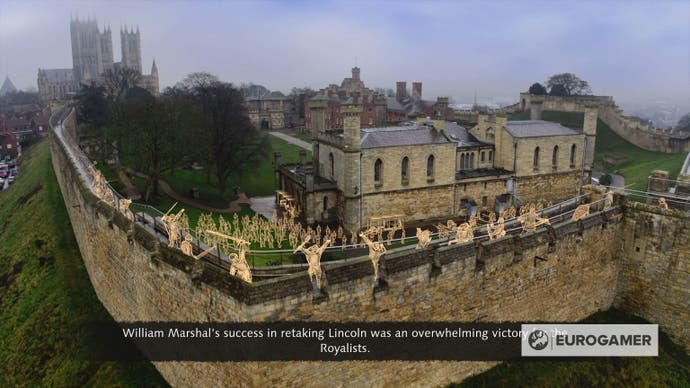
That's underselling it a bit - the Mongol campaign takes you to the Great Wall, for a start - but there's such a parochial charm to the documentary sections that the tone still stands out. There are some quirks, as AoE 4 takes quite a bluntly factual approach to history: this battle happened here at this time, this side won, then this happened. At one point you take on the role of King John, crushing the "rebel barons" who held out at Rochester Castle. A slight bit of nuance missed there is that those traitors were doing a treachery because King John had signed, and then reneged on, the first Magna Carta, and as far as my admittedly very-much-still-Year 5 level memory of this history lesson goes, I'm fairly sure that document was quite important. In the historical community there's some back-and-forth about just how bad a bloke John was, and that's really the point: the occasional factual greyness of history, the debates about causes and outcomes and how much weight is assigned to them all is part of the fun. It would've been nice, in simple terms, for the historical campaigns of AoE 4 to dig into the foggier nuance a smidge more than "you're the King; kill the rebels".
It's barely a quibble though really, as although the campaigns miss out on the campy voice acted scenes of the series' wonderful spin-off Age of Mythology, they're otherwise still a perfectly enjoyable romp through time, and they get more varied as you move away from the knightly warfare of central Europe into the more aggressive Mongol playstyle. Occasionally, the pacing can be a little wobbly. Most of the more complex levels, for instance - especially in the Norman and French stories - involve a fairly flat middle section where you'll need to simply camp out and tech for a while, defending yourself from minor attacks while slowly but surely building up the resources for a decisive counter, and it means things do tend to drag a bit. But the challenge itself is significant - on Intermediate difficulty I failed a couple of missions the first time I tried them, just by virtue of not really taking things seriously enough. That just-tough-enough pitching is spot on.
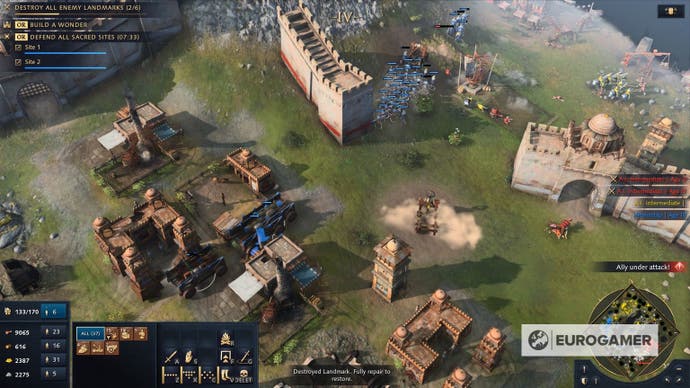
Similarly well-balanced is AoE 4's multiplayer, which is where most players will spend most of their time. There are eight civilisations at the moment, spread quite evenly across Europe, Asia and Northern Africa. Naturally all of them have their own unique bonuses and specialised playstyles but in the first month or so after launch, what's noticeable is that there's no one civilisation that's clearly dominating the others, and no absolutely must-have strategy either. Obviously some elements dominate within the civilizations - the English peak earlier with their Longbowmen for instance, while the Chinese start slow but become a hugely challenging late-game powerhouse if you let them - but aside from some recently toned-down springald damage, AoE's sacred rock-paper-scissors triangle of spearmen, archers, cavalry remains level and intact.
That said, this is where AoE 4's main divergences from the formula start to pop up. For one, there's an official "light" and "heavy" distinction between military units for the first time, with specific counters within those. Crossbows do bonus damage against those heavily armoured units, for instance - including heavy cavalry - while light, raiding cavalry get the major bonus against archers. It's one seemingly small tweak, but also one that immediately doubles the level of complexity, splitting what is at its core a fairly small roster of units into a more sophisticated matrix of counters and counter-counters.
There are other small tweaks: one little early game change has been made to sheep, that puts the herding responsibility on your scout specifically, who must gather and lead them back to your town centre when you first start the game. Immediately there's a nice little trade-off between aggressively scouting your enemy for a rush, and gathering more food for your villagers to speed into the second era. Villagers gather faster, generally, than in spiritual predecessor Age of Empires 2, meaning you'll need fewer overall by comparison. In the late game, you win by taking out those aforementioned landmarks - a few key buildings - instead of grinding away against toxically stubborn foes' every last building on the map. They're all very welcome changes, and there are more.

Standard units can't attack walls anymore, which makes more sense in theory and, more importantly, places more emphasis on siege weapons in practice. Those have in turn become a little dominant in the first month or so until a couple of recent tweaks from Relic. And again, the theme here is balance - or really a kind of perfect imbalance, which is what true balance really is after all. Each civilisation has outsized strengths that can snowball a game, and each has to be dealt with in kind.
Beyond that, what stands out with AoE 4 is a seemingly loving attention to detail. I've spent far too much of my free time watching YouTube tutorials about farming efficiency, but one curious point that highlighted for me is how each farm is actually split into a hidden grid, with wheat regrowing in those mini-grids at a specific order and specific rate - but, the Chinese civilisation grows rice instead of wheat, and rice grows at a different rate in a different pattern within that one farm. The upshot is this leads villagers to move in slightly different patterns depending on the type of farm, and so the Chinese actually farm marginally slower in the early game but marginally faster after the same upgrades as other civs later on. It's an almost indiscernible difference to a layperson, but one placed there knowingly, and subtly it's one more little thing that tinkers with the teetering scales. Another quick food-based factoid, while I have you: unlike the other civs, the Abbasid and Delhi Sultanate civilisations can't set their villagers to farm wild boar, in an accurate nod to the rules of their religion.
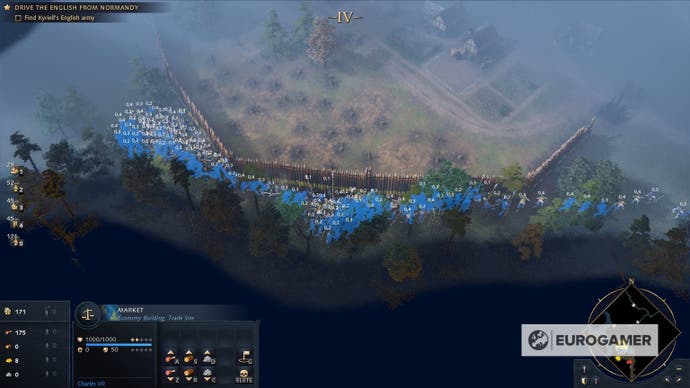

There are a couple of hiccups, still. Unit pathing is a tad clunky, with a lot of bumping into one another when in large groups and a tendency for ranged units to pump dozens of arrows into one foe at a time - although it's at least a predictable bit of AI logic, so that does mean that a player who's capable of putting that extra care into micromanagement will come out on top. It's less manageable against the AI enemies, which can get themselves into weird situations where groups of units perform a clumsy stop-start shuffle when chasing certain units across the map. There's also some fiddliness to things like actually clicking on and picking up treasure, and I found the odd, fussy bug with placing relics a couple of times.
But that's it, in my experience. Quite something, given this is a new studio taking up the mantle, and those little bumps do nothing to derail the otherwise brilliant nuance that Relic has added to an already wonderfully nuanced series.
It's those little nuances, too, that set AoE 4 apart, giving it that lovely vein of hidden depth to be mined from beneath the initial simplicity, the fabled "easy to learn, not just difficult but nigh on impossible to master" tag that's always been such a holy grail for games in this genre. A week or so with it and I can feel those old, familiar tendrils of strategic curiosity wrap around me, drawing me in with an urge to improve, to develop, to economise, to learn. It's wonderfully appropriate, and really, in a way, what this game is all about. Through its canny tutorials, docu-series campaigns and bottomless well of multiplayer depth, Age of Empires 4 wants nothing more than to simply teach, and I am nothing less than delighted to return to my role as its student.
